
A railcar is a self-propelled railway vehicle designed to transport passengers. The term "railcar" is usually used in reference to a train consisting of a single coach, with a driver's cab at one or both ends. Some railway companies, such as the Great Western, termed such vehicles "railmotors".

The 620/720 class railcars are a class of diesel-hydraulic multiple units (DHMU) built by the New South Wales Government Railways and operated from 1961 until 2007.
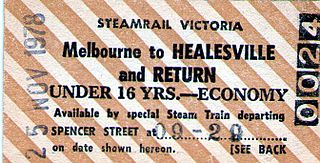
The Healesville railway line, in Melbourne, Australia, was the non-electrified continuation of the suburban Lilydale line, extending into the Yarra Valley. The line closed in the 1980s, but a heritage railway group, the Yarra Valley Railway, is working to retain part of the line between Yarra Glen and Healesville.
Railmotor is a term used in the United Kingdom, Ireland and the Commonwealth for a railway lightweight railcar, usually consisting of a railway carriage with a steam traction unit, or a diesel or petrol engine, integrated into it.

Commonwealth Engineering, often shortened to Com-Eng, later known as Comeng [ KOM-enj], was an Australian engineering company that designed and built railway locomotives, rolling stock and trams.
The government railways of New South Wales, Australia, use a large variety of passenger rolling stock. The first railway in Sydney was opened in 1855 between Sydney and Granville, now a suburb of Sydney but then a major agricultural centre. The railway formed the basis of the New South Wales Government Railways. Passenger and freight services were operated from the beginning. By 1880, there was a half hourly service to Homebush.
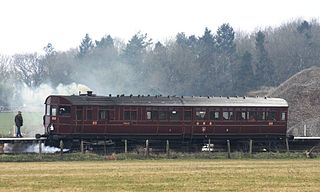
The steam rail motors (SRM) were self-propelled carriages operated by the Great Western Railway in England and Wales from 1903 to 1935. They incorporated a steam locomotive within the body of the carriage.

The Gulflander is a passenger train operated by Queensland Rail on the isolated Normanton to Croydon line in the Gulf Country of northern Queensland, Australia.
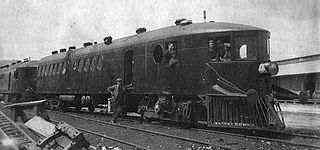
The McKeen Railmotor was a 6-cylinder self-propelled railcar or railmotor. When McKeen Company of Omaha, Nebraska, U.S.A., first unveiled the car in 1905, the McKeen was among the first engines with a distillate-fueled motor. Revisions to the McKeen car led to the modern self-propelled gasoline rail-motor vehicle, and the "contours of the porthole windows, the front-mounted gasoline engines, and other features anticipated the streamline concept."
The Kerr Stuart steam railmotor, also known as Motor Car 3, was a steam railcar operated by the Victorian Railways from 1913 to 1924.
The MT type carriages were railmotor trailers, used on the Victorian Railways (VR) in Australia.

Tulloch Limited was an Australian engineering and railway rolling stock manufacturer, located at Rhodes, New South Wales.

The 600/700 class railcars are a class of diesel multiple unit built by the New South Wales Government Railways. They were built to operate on branch lines from 1949 with low traffic volumes later being transferred to Newcastle and Wollongong to operate suburban services until withdrawn in 1994. However, one 600 class railcar was converted to solar operation for use on the Byron Bay Train service. The upgraded train entered service on 16 December 2017 and is believed to be the world's first solar-powered train.

A steam railcar is a rail vehicle that does not require a locomotive as it contains its own steam engine. The first steam railcar was an experimental unit designed and built in 1847 by James Samuel and William Bridges Adams. In 1848, they made the Fairfield steam carriage that they sold to the Bristol and Exeter Railway, who used it for two years on a branch line.
The 1100 class railcar or Budd railcar were a type of diesel railcar built by Commonwealth Engineering for the Department of Railways New South Wales in 1961. They primarily operated on the South Coast Daylight Express until withdrawn in 1993.

The 2000 class railcars are a class of self-propelled railcars built by Commonwealth Engineering, Rocklea for the Queensland Railways between 1956 and 1971.
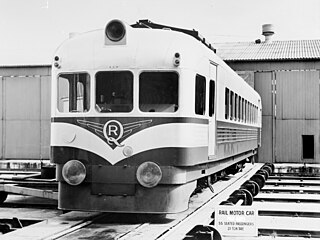
The 1800 class railmotors were a class of self-propelled diesel railmotors built by Commonwealth Engineering, Granville for the Queensland Railways.

The WAGR WCA class railcars and WCE class trailers were built by Comeng, Granville for the Western Australian Government Railways in 1971 to operate the new Prospector service between East Perth and Kalgoorlie. At the time of their construction the WCA class units were the longest and fastest diesel railcars in the world.
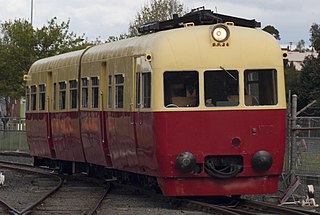
The Tasmanian Government Railways DP class was a class of diesel railcars operated by the Tasmanian Government Railways.
The NDH class railcars are a class of self propelled diesel-hydraulic railcars designed by Commonwealth Engineering and built by the Gloucester Railway Carriage & Wagon Company in England for the Commonwealth Railways, Australia in 1954. They were known as Gloucester railcars.















